Czech Model 1/32 Lockheed F-80C Shooting Star
By mid-1943, it was obvious that the Bell P-59A Airacomet, the first U.S. jet fighter was a failure, being far too heavy and unable to give a higher performance than either the P-47 or P-51, with little opportunity for further development without a major redesign. The leaders of the USAAF turned to Clarence “Kelly” Johnson and Lockheed Aircraft to give them a solution. Kelly's design unit - already known as “The Skunk Works” - presented a concept for a single-engine air superiority fighter, which resulted in a design specification being written around the proposal and issued by the USAAF in May, 1943. The company designation was Project MX-409. A contract for a prototype was signed June 17, 1943.
The prototype, now known as the XP-80 and nicknamed “Lulu-Belle”, was completed in 141 days, just in time to be mated to the British Goblin turbojet - which had been taken directly from the first Vampire prototype and shipped to the United States. On January 8, 1944, what was known to Lockheed personnel as “The Green Hornet” for its forest-green paint scheme, was wheeled out before Air Force brass at Muroc Field. With Tony LeVier in the cockpit, the little jet roared down Runway 23, lifted off, and then quickly returned to earth when the landing gear failed to retract. With that fixed, he started up again, took off and soared into the clear California skies. Over the next hour, LeVier gave the assembled audience an air show that clearly demonstrated the wonderful flying characteristics the P-80 would become known for.
With the knowledge that the German Me-262 was close to entering production, development was accelerated on the P-80, now known as the “Shooting Star.” In February 1944, a contract was let for production of 13 XP-80A aircraft, which would have a longer fuselage and a different engine, the General Electric I-40, later known as the J-33. A production order for 500 P-80As followed in March 1944. The XP-80As began delivery in September 1944, and in February 1945, three YP-80A aircraft went to England, with two going on to Italy, where they took part in operational development flights in the combat environment, though neither aircraft took part in any direct combat operations. Additional work was found necessary on the fuel pump, following the death of Lockheed test pilot Milo Burcham and America's Ace of Aces Dick Bong, both through flameouts on takeoff due to fuel starvation.
Following the end of the war, the Air Force moved to bring the P-80A into service, with the 412th Fighter Group, which had been the only unit equipped with the P-59A, receiving their P-80s in November 1945. Over the next four years, the P-80 - known after October 1948 with the creation of the United States Air Force as the F-80 - became the primary Air Force jet fighter. In 1948, with the outbreak of the Berlin Crisis, a squadron of the 56th Fighter Group led by Colonel David C. Schilling made the first west‑to‑east Atlantic crossing by single‑engined jets that July, flying to Germany for 45 days in Operation Fox Able I, while that fall the 36th Fighter Group at Fürstenfeldbruck became the first European-based unit to fly the F-80. That November, the 51st Fighter Group in Japan became the first unit in the Far East to operate the fighter.
The major fighter model was the P-80C, with production encompassing 162 P-80C-1‑LO, 75 5‑LO and 561 10‑LO production blocks. Redesignated as the F‑80C, 128 original F-80As were brought up to the F‑80C‑11‑LO standard. The F-80C was powered by the J33‑A‑35 engine and received an early ejection seat (actually a catapult seat) as factory-installed equipment, and was also the first USAF fighter to feature an effective explosive canopy jettison process. Following the outbreak of war in Korea, with a need for increased range, wingtip tanks carrying 260 gallons, known as “Misawa tanks” for their place of production in Japan, replaced the earlier 150 gallon tanks based on those used by the P-38.
When war came in Korea with the invasion by North Korea on June 25, 1950, the American forces in Japan were far from ready for combat. US Forces were authorized to entire combat by President Truman on June 26, 1950. The 51st Fighter Group had been operating the F-80 since the end of 1948, while the 8th Fighter Group had only recently converted to the airplane from P-51 Mustangs. Fortunately, with a major officer reduction‑in‑force having been completed over the previous six months, most pilots were experienced, stable, and seriously aggressive. At the outbreak of war, a substantial number of F-80s could not carry either wing-tip tanks or bombs.
There were no forward airfields in Korea that could handle jet aircraft, which meant the F-80s had to fly from Itazuki AFB on Kyushu, and had an effective loiter time of only 20 minutes over the 38th Parallel, the point of invasion. The Misawa tanks that were quickly produced by adding an extra section to the existing tank, were heavy enough that some aircraft eventually suffered wing failure.
The 8th Fighter‑Bomber Wing, composed of the 35th, 36th, and 80th Fighter‑Bomber Squadrons, was the longest‑serving F‑80 unit in Korea and continued to fly the Shooting Star until May 1953, when it converted to F‑86 Sabres. The Shooting Star first saw air combat on June 27, 1950, when the 8th Fighter Bomber Wing launched four F-80s of the 35th FBS, flown by 1st Lt Robert Dewald, 1st Lt. Ralph Hall, 1st Lt Wayne and led by CAPT Ray Schillereff, to patrol Kimpo Airfield at Seoul while General MacArthur flew into Kimpo for a first-hand look at the situation.
The first American aerial victory of the war happened over Kimpo, and went to 1st Lt Hudson, flying an F-82G of the 68th All-Weather Fighter Wing; the F-82s were patrolling Kimpo to protect the evacuation of American personnel by C-54s, when North Korean aircraft made a low-level strafing attack. Hudson shot down what was believed to have been an Il-10 Shturmovik, but might have been an La-9 or a Yak-9U. An hour later, the four F-80s from the 35th FBS were in action against North Korean Il-10 aircraft that swept in over Kimpo at low level. While there is no dispute that the 35th FBS got the USAF's first jet kill, there is dispute over who actually got that first jet kill. According to “Crimson Sky: The Air Battle for Korea,” 1st Lt Robert Wayne, covered by his wingman 1st Lt Ralph Hall, shot down the first two Il‑10s, with CAPT Ray Schillereff and 1st Lt Robert Dewald picking off one each of the fleeing bombers. Other sources say that Schillereff and Dewald were the first victors, which demonstrates just how fast the fight happened.
The first fighter‑bomber missions were launched on June 28, 1950. These were mainly armed reconnaissance missions aimed at blasting moving columns of enemy equipment, supplies, and personnel. They were not particularly effective at first, due to the fact the 8th Fighter Bomber Wing had not gotten into gear before the war, and the pilots did not have the training in ground attack to operate effectively. Thus, the unit's pilots taught themselves through often-deadly experience how to do their job. Over the next two and a half years, of the 277 F‑80s lost in operations - approximately 30% of the existing inventory - 113 were destroyed by ground fire and 14 were shot down by enemy aircraft
As is pointed out in “Crimson Sky,” “...F‑80 pilots felt they were doing the dangerous interdiction work but receiving no credit... As a result, fighter‑bomber units took greater pride in unit accomplishments versus the individual pilot accomplishments. Squadrons had special baseball caps and beer steins made. Each squadron custom‑designed and ordered its own cap from Japanese manufacturers. The squadron logos in Korea were emblazoned on caps, signs, beer mugs, jackets, and flight suits." The operational life of a fighter‑bomber pilot was hazardous and often short. 147 Air Force aircraft were lost in air‑to‑air combat; by comparison, over 816 aircraft were shot down by ground fire. As Raymond Sturgeon, a pilot with the 35th FBS, put it, "I had friends in F-86s who never saw a MiG their entire tour, but we got fired on every mission with high‑powered guns that shot golf balls at you. The 35th FBS lost a pilot or two every week, and losses like these were not unusual in the Wing."
I found it surprising to discover that the pilot whose airplane is Markings Option Number 3 in this kit was a man I had never heard of before. It turns out, Levi R. Chase was the top-scoring American fighter pilot during the North African campaign with 10 victories, and the only American fighter pilot to score against all three Axis air forces (9 German, 1 Italian, 2 Japanese). He served with the 2nd Air Commando in the CBI, where he led the longest P-51 mission ever flown. He won three Silver Stars for combat leadership in three different wars, and the British awarded him the DFC twice, while the French awarded him the Croix de Guerre. To top it all off, Chase was the founder of the Air Force flight demonstration team, The Thunderbirds, and retired as a Major General with close to 6,000 hours in fast jets. Here's his story:
Levi R. Chase was born in Cortland, N.Y., on December 23, 1917. Quitting college during his junior year at Syracuse University in November 1940 because he could see war was coming, Chase joined the Air Corps and was accepted as an aviation cadet. As a member of Class 41‑G, he received his pilot wings and commission as a Second Lieutenant in September 1941 at Maxwell Field, Alabama, and was assigned to the newly-formed 58th Pursuit Squadron of the 33rd Pursuit Group.
Chase first saw combat with the 33rd Fighter Group in November 1942, when they flew their P-40Fs off the USS Ranger to join Operation Torch. By that December, he'd been promoted to Captain and scored two victories - a Bf-109 and a Ju-88. At the time of the German surrender in Tunisia in May, 1943, Chase was a Major, Squadron C.O. of the 60th Fighter Squadron, and the leading American ace of the campaign with ten victories - eight Bf-109s, one Ju-88, and one Macchi C.202. In addition to aerial fighting, he'd become a leading exponent of close air support for the ground forces when the 33rd worked with the French armored unit and the British Eighth Army during the fighting after Kasserine Pass. Like many of the leading P-40 pilots, he believed the airplane was better than the tales told about it, so long as one kept their speed up and stayed in the vertical plane, not playing the enemy's game in combat.
The 33rd Fighter Group was led for a time by the legendary Phil Cochran, who later was the prototype hero for the "Terry and the Pirates" comic strip. Cochran dubbed Chase his "One‑Man Wave of Terror" for his aggressive and relentless pursuit and attack of enemy targets in the air and on the ground. The Free French awarded him the Croix de Guerre for his work in support of General LeClerc's armored unit during the assault on the Mareth Line, while the British awarded him the Distinguished Flying Cross twice for close support operations in support of the Eighth Army.
Following the Tunisian campaign, Levi Chase returned to the United States, where he made war bond tours and then worked in the training command with his old C.O. Phil Cochran and new friend Major Johnny Alison, formerly of the 23rd Fighter Group. When Cochran and Alison formed the 2nd Air Commando Group, he went along as the fighter commander.
Chase was a very effective leader of the First Provisional Fighter Group during his second combat tour in the China-Burma-India Theater. Flying from Cox's Bazaar in India, he led the two squadrons of the 2nd Air Commando in a mission to strike Don Muang Airfield in Bangkok on March 15, 1945, a mission that covered over 1,500 miles round trip, and was the longest P-51 mission ever flown. For this, he was awarded the Silver Star, while the 1st Provisional Fighter Group received a Distinguished Unit Citation. Earlier, during the Chindit operation in Burma, Chase was shot down behind enemy lines and crash-landed. Two of his pilots landed at Broadway airfield and took two L-5s to go find him. One landed and picked him up, while a Japanese patrol was just over the hill from them. During this second combat tour he shot down two Oscars, thus becoming the only American fighter pilot to score against all three Axis powers.
After the war, Levi Chase returned to civilian life, to his wife and eldest son. He returned to college, finished his degree and then gained a law degree from Syracuse University in 1949. The Korean War brought his recall to active duty, which was something he did not complain about. He served successively as the Deputy Group Commander of the 1st Fighter Group, flying the F-86A Sabre; Executive Officer of the 56th Fighter Interceptor Wing and then Commander of the 63rd Fighter Interceptor Squadron. In November 1951, he went to Korea, where he served as Deputy Commander, Operations, in the 51st Fighter Interceptor Wing, as they transitioned to the F-86. In April 1952, he became Group Commander of the 8th Fighter Bomber Wing. During his time in command, he made a point as Wing Commander to lead the “tough missions”, including the strikes against Pyongyang in the summer of 1952, for which he received his second Silver Star.
In December 1952, he returned to the United States to become Commander of the 3600th Combat Crew Fighter Training Wing at Luke AFB in Arizona, where he founded the USAF Flight Demonstration Team known as The Thunderbirds.
In 1963, Colonel Levi Chase was assigned as commander of the 12th Tactical Fighter Wing, the first USAF unit to operate the F-4C Phantom. He took the unit to Vietnam in 1965, flying out of Cam Ranh Bay in strikes through both North and South Vietnam, during which service he received his third Silver Star for bravery and combat leadership.
Promoted to Brigadier General in 1969, Chase was promoted to Major General in 1972 and retired from the Air Force in 1973 as Commander of Ninth Air Force. His last flight as Pilot in Command was at Shaw AFB in 1973, flying an F-4E Phantom. At that time, he had logged over 5,700 hours in jet fighter aircraft. He died in 1996. Chase's son, Tom, wrote of his father: “Levi Chase took his roles as an Air Force officer, commander and fighter pilot quite seriously and did not seek publicity. He did not want to see the serious business of war and military service glamorized or trivialized. In short, he did not seek the limelight. Unfortunately, this means that despite his combat record and accomplishments, he was not as well‑known to the public as many other fighter pilots who may have been covered a bit more by the press.”
I think this is the most accurate F-80 kit out there. I ended up using the True Details cockpit, which really improves things and which I recommend, and the True Details "Misawa" tanks, which are big heavy lumps of resin that cause more trouble than they solve any problem and I don't recommend. Consider the kit a limited run kit and you'll do fine. Cut the intake trunking at the "V" and install each side individually before closing up the fuselage and you'll save yourself a lot of grief and your children won't learn new words you weren't planning to teach them.
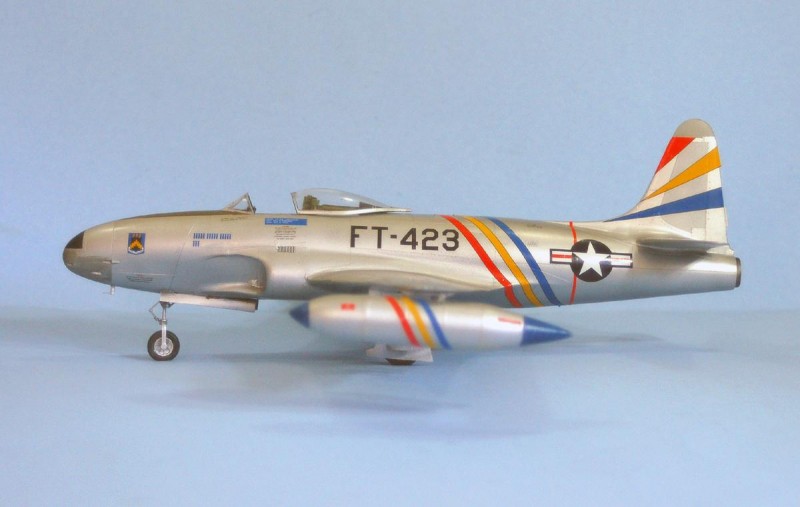
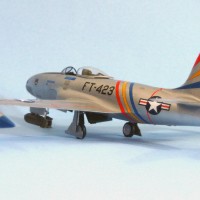
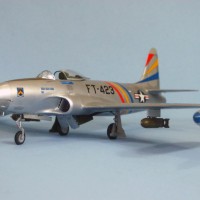
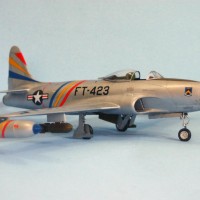
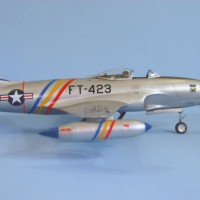
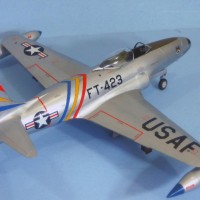
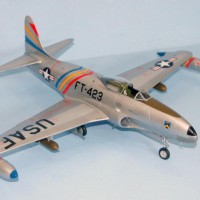
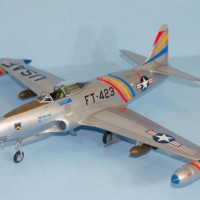
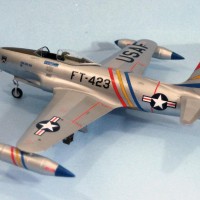
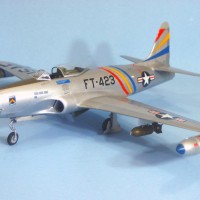
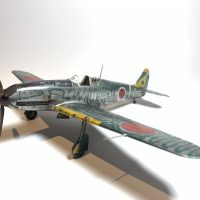
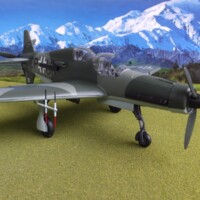
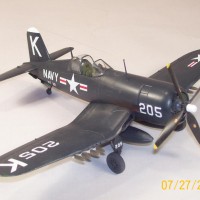
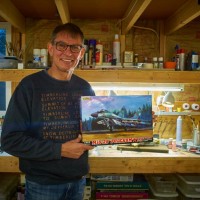
Really pretty Tom. The P-80 was a looker in my book. Nice work on the model as usual.
This is a nice scheme! Colorful yet restrained. What did you mean about using the True Details cockpit? I thought they tossed one in on every kit, although I've only built a few of the older offerings. Does this newer Czech release give you an all styrene option?
Yes, both the F-80 and T-33 have all-styrene cockpit options, with the resin cockpit as an "aftermarket alternative." Probably a cost-cutting measure to get the kits out the door (and bring in additional revenue from the "resinaholics" who probably end up paying more for the resin cockpit separately than they would if it had been in the kit).
Tom...Very nicely done and I enjoyed your interesting recap of the history of the F-80.and the story of Levi Chase.
Tom,
Very nicely done. Enjoyed the story and looking at the fine model you did here. I have this kit and your article may get me inspired to build it soon.
You certainly have a way of producing these early jet models that make me want to buy one, thank you, Tom.
super nice build